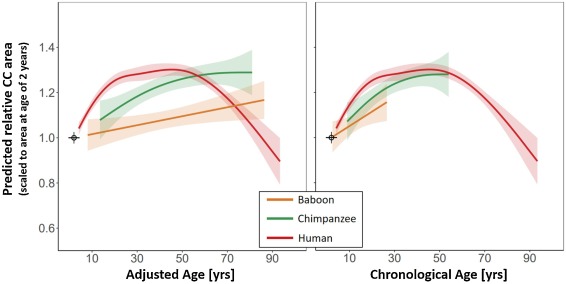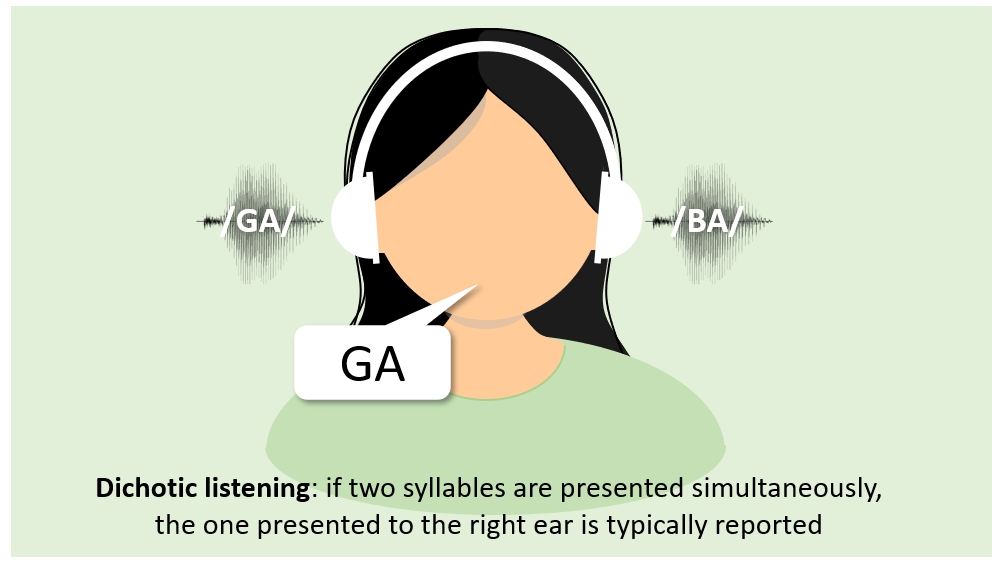The most salient anatomical feature of our brain is that it consists of two hemispheres. These two halves of the brain complement each other. They are specialized for different, interdependent cognitive functions, and receive divergent, yet related information from the senses. For example, about 95% of right-handed individuals understand and produce language with their left hemisphere, while the right hemisphere supplements this processing by analyzing prosodic information. This pattern of functional segregation between hemispheres has been thought to come with the advantage of preventing conflict of duplicate (redundant) information and enhancing cognitive capacity by allowing for parallel processing. At the same, this asymmetric set-up demands integration both by sharing of information between and coordinating processing in the two hemispheres. While this interaction between the hemispheres is done mainly via axons that from the corpus callosum, the nature of this interaction is far from understood.
An overview of recent activities
Visual artists are not more often left handers
A series of famous visual artists, like Leonardo da Vinci, Paul Klee, or Maurits C. Escher, are said to have been left handers, and examples like these have contributed to the popular belief that left handedness was associated with a special artistic talent. However, besides this anecdotal evidence, the somewhat limited scientific literature provides, at best, modest evidence in support of this claim. Thus, to investigate the postulated association, we conducted an observational study on the social media platform “Instagram” examining the hand preference of visual artists who share video clips (“reels”) of their artistic activities. We found that roughly 9% of the artists showed a left-hand preference, which is (statistically) comparable to the 10-11% expected for the general population. Also, the such identified left-handed artists did not attract more “likes” or “followers” than their right-handed counterparts. In summary, we do not find any indication that left handers are more talented for visual artistic activities.
Effects of corpus callosotomy on visual and auditory processing
The corpus callosum, as the major commissural pathway, has a central role in the integration of information processing between the two cerebral hemispheres. This role has been impressively demonstrated on so-called “split-brain” patients that have undergone a surgical section of the corpus callosum to treat an otherwise intractable epilepsy. For example, as shown in a recent study from our lab, a complete section of the corpus callosum (called “callosotomy”) prevents patients from attending and reporting the information presented to the left ear in dichotic listening. However, like the above study, studies on split-brain patients are typically case studies including (at best) a small number of cases. Unfortunately, a case study – taken alone – is not able to convincingly separate case-specific (e.g., individual brain pathology, adverse effects of the surgery) from general brain characteristics, limiting the generalizability of the findings and increasing the risk of overinterpretation. To overcome this limitation, we recently conducted a series of meta-analyses to systematically integrate evidence across all published cases tested with either of three frequently used experimental paradigms to assess interhemispheric communication: the bilateral redundant target and Poffenberger paradigm (published here), as well as dichotic listening (preprint). In brief, these meta-analyses were able to document both the restrictions to and residual capacities of interhemispheric integration after callosotomy.
Handedness is not related to morphological differences in the corpus callosum
In the 1980s a series of influential publications suggested that mixed- as opposed to right-hand preference is associated with a larger corpus callosum. Since then, callosal differences due to handedness are commonly referred to when behavioural differences between handedness groups have to be explained. However, in a recent meta-analysis and in a separate empirical study, we were able to show that the effects of handedness are small and likely negligible for behaviour. A recording of a presentation of the findings at the North Sea Laterality meeting 2022 in Bergen, can be found here.
The corpus callosum of human and non-human primates ages differently
The human corpus callosum changes across the life-span: a rapid growth during the infancy and early childhood reaches peak in the third life decade, and a significant decline can be seen above the age of roughly 50 years. In a series of papers including data from chimpanzee and baboons, we found that a comparable decline in old age cannot be found in non-human primates. The reason for this divergence remains unclear, but it might be speculated that it is the consequence of an accentuated growth of the human corpus callosum in early development leading to extraordinary strong connectivity between the hemispheres which cannot be upheld in the aging brain.

Dichotic listening is a reliable method to assess hemispheric dominance for language
Dichotic listening simultaneously presents two competing auditory-verbal stimuli, like syllables “ba” or “ga”, one to the left ear and the other to the right ear, while the participant is asked to report the stimulus heard most clearly. Typically, the right-ear stimulus is reported more often and faster than the left. This right-ear advantage is thought to reflect the left hemispheric dominance for speech processing. One long-known short-coming of the method is that it underestimates the number of individuals with left hemispheric dominance, which might be attributed to suboptimal design and inference processes. Thus, we (a) developed and tested an evidence-based “optimized” version of the paradigm which promises high reliability, and (b) designed a Bayesian inference method to improve the inference form observed right-ear preference to latent hemispheric dominance.
